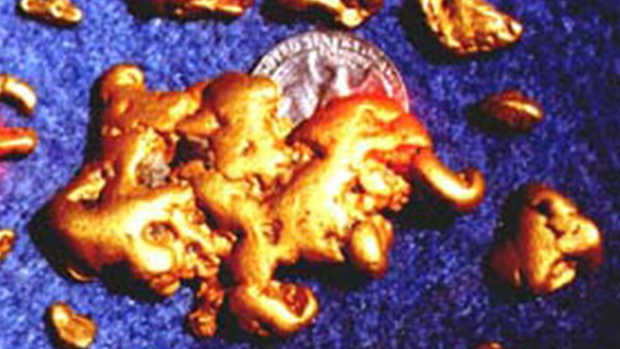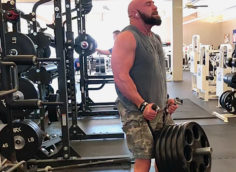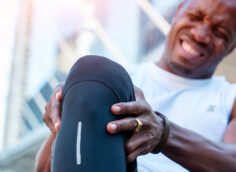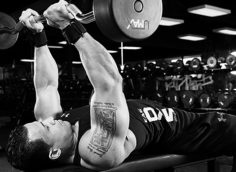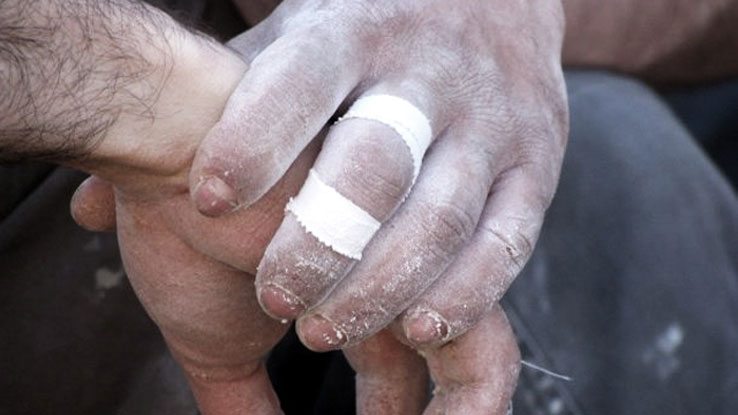Coach Christian Thibaudeau has spent hundreds of hours on the
T-Nation forum and Author's Locker Room answering reader
questions.
 |
These posts are a goldmine of training and diet info. Problem
is, many of these posts are buried in endless threads. So, we
decided to do a little mining. Here's just a sampling of the cool
info nuggets we discovered.
Twice-Per-Day Training
Q: Hey Thib, got any guidelines for twice-per-day lifting?
A: I have a confession to make: I don't really like being in the
gym. That's right, despite my love for the iron game, I just can't
wait to get out of there! That's why I personally love to train
twice per day.
Wait a minute, you're probably thinking, you just said that you
hated being in the gym, so why train two times in one day? Well,
performing twice-a-day workouts allows me to use very short
sessions each time. I prefer to do the same amount of work (or only
slightly more) in two short sessions than in one big workout. There
are several advantages to this:
1. Being in the gym for only 25-30 minutes doesn't give you time to
get bored! You won't lose motivation.
2. Your overall work quality is much higher. By splitting your
workload in two daily sessions, you're fresher for the second half
of the workout, which means greater gains.
3. You burn more calories. A study by Almuzaini et al. (1998) found
that when the same volume of work is divided into two sessions, the
total amount of calories burned is greater, mostly due to a higher,
more sustained post-exercise oxygen consumption
So for individuals wanting to gain a lot of muscle, this will
make it possible to eat more good food without gaining as much fat.
And for individuals looking to get ripped, well, the advantage is
self-evident!
4. When you perform the same amount of work divided into two
sessions you can recover faster from the workload and thus progress
at a more rapid pace.
5. Fast-twitch individuals and people with an efficient nervous
system seem to respond much better to split training than to one,
longer session.
6. You can see twice as many vixens in the same day!
Now, twice-a-day sessions seem to be the Holy Grail, and in some
cases they can be. However, it's easy to abuse such a method. Many
people will make the mistake of actually doubling their workload –
doing two big sessions instead of two small ones. This is one of
the fastest ways to stagnate.
Another classic mistake is to work on the same physiological facet
in both sessions. To make the most out of twice-a-day sessions you
should vary the type of demand you place on your body. I found that
having a functional emphasis in the morning session and a
structural emphasis in the evening session to be the best way to
train.
A final mistake is to work different body parts on each of the two
sessions of a same day. All it does is reduce the recovery time
that each muscle group receives (each muscle's turn comes back
faster). Furthermore, since you only use a very low volume of work
at each session, doing different body parts on each session will
actually reduce the training effect.
 |
So how can you make it work? If you respect the following
guidelines you should benefit greatly from twice-a-day
sessions:
1. Train for no more than 30-40 minutes in the first session and no
more than 20-30 minutes in the second.
2. Train the same muscle in both daily sessions.
3. Include more functional-oriented training in the first session
of the day. This means heavier weights, more acceleration, or more
complex exercises.
4. Include more structural-oriented training in the second session
of the day. This means more volume, less weight, and a slower
tempo.
5. Use a good post-workout drink like Surge Recovery after every
session.
6. Train each muscle only once a week. You can pair muscle groups
and train four days per week or only work one muscle per day and
train six days per week.
On-Day and Off-Day BCAA
Q: I want to start using BCAAs as recommended by many T-Nation
experts. What's the best way to consume 40-50 grams of BCAA on off
days when one consumes five or six meals already?
A: On non-training days, I suggest ingesting the BCAAs either between
meals or 15 to 20 minutes before each meal. For example, if you eat
five times a day, ingest 10 grams of BCAA 20 minutes prior to each
of those meals. You can also replace one of the pre-meal servings
with a serving before going to bed.
Now, since all of my athletes eat at least five or six times a day
and my five times per day BCAA protocol was designed after
experimenting with them, here's when to take your BCAAs:
1. First thing in the morning upon rising
2. Either between breakfast and your first snack, or between your
first snack and your lunch
3. Before training or between your lunch and your afternoon
snack
4. During your lifting session (better suited for a mass-gaining
phase) or with your post-workout drink (better suited for a fat
loss phase). If you're using Surge, this is already taken care of
(tons of BCAA already in there!)
5. Before going to bed
Pre-Contest and Hungry!
Q: What's the best thing to eat as a snack without harming fat
burning during pre-contest? I get so hungry!
A: As a snack I like celery with no-fat cheese and big salads:
lettuce, cucumbers, tomatoes, some chicken or tuna, avocado, and a
bit of either flax oil or olive oil.
Since I have a sweet tooth I also make protein popsicles. Mix some
sugar-free Jell-O with whey protein and sugar-free diet soda. Poor
the mix into an popsicle mold and put it in the
freezer.
 |
The sugar-free Jell-O plus diet soda (ideally diet cream soda)
gives the ice pop basically the same texture as a real popsicle and
makes it more palatable without adding any calories.
Creatine and Fat Loss
Q: What do you think about taking creatine while
cutting?
A: I wouldn't say that it's a "must," but it's pretty darn close
to being one. While on a diet, creatine will allow you to be able
to sustain a higher level of effort in the gym. It'll also swell
your muscles which is helpful psychologically (you won't feel as if
your muscles are wasting away because they're
"flat").
Low Calorie Lifting
Q: I'm on a fat loss diet with low calories and I'm bonking
during my normal training. Any tips?
A: When calories are super low and you feel lethargic or lack
energy, only one rule applies: train the way you can!
 |
In that situation, some people can't lift heavy while others
can't handle high reps. When cutting calories this much (with the
obvious goal of losing as much fat as possible), all you can hope
for is to maintain your muscle mass. So what you want is a type of
training in which you'll at least be able to have quality
workouts.
Most people do better with lower reps when drastically cutting
calories and carbs because sets lasting less than 20 to 25 seconds
don't rely on glycogen for fuel as much. So when running on empty
glycogen stores, low rep training might be best.
And I do believe that trying to maintain or even gain strength
while dieting is the best way to force your body to hold on to its
muscle.
How To Build Intercostals
Q: Check out this picture of 70's bodybuilder Moses Ashby. How
the heck do people build such thick intercostals?!
 |
A: The external intercostal muscles connect ribs together and
allow them to move during the breathing process. These muscles are
active during inhalation. The deeper and more forceful the
breathing, the more active the intercostals.
Now, heavy breathing exercises might be of some help and old-timers
believed that a superset of breathing squats and barbell pullovers,
taking a deep breath during the slow eccentric phase, could help
build the intercostals and expand the rib cage.
Is there any truth to it? Maybe as far as strengthening the
intercostals there is. But even then I think that the growth
potential of this muscle group is minimal. So when someone has deep
intercostals I'll have to say it's genetics.
The figure below illustrates the role of the external
intercostal muscles during breathing. The "cream" portion
illustrates the rib bones at rest while the "toilet green" portion
illustrates what happen when we take a deep breath. The rep portion
is an intercostal muscle which pulls the ribs up to expend the rib
cage.
 |
However, I really think that in the picture we're seeing the result
of a well developed serratus more so that intercostals.
 |
So how do we build the serratus? The serratus is involved mostly
in the very last portion of the vertical and horizontal pressing
motions as well as during shrugging motions.
At the end of a bench press, incline press, or overhead press, try
to reach even higher with the bar (via an upward action of the
shoulder girdle), basically reaching for the ceiling, trying to
bring the hands as high as possible. Hold that position for two to
three seconds.
Training and Soreness
Q: What's your take on training through mild
soreness?
A: I personally feel that it's okay to train a sore muscle.
Using relatively light weights and high reps can actually speed up
the recovery from training-induced soreness. Just avoid training an
injured muscle.
Cardio and Contest Dieting
Q: How much cardio did you do during your last contest prep?
What type of cardio do you prefer for competitive
bodybuilders?
A: When on a severe caloric deficit, I recommend low-intensity
cardio to avoid muscle breakdown due to excessive glycogen
depletion.
My contest preparation period lasted five months. I performed
cardio for the first two months to get the fat burning process
started without cutting calories too much. Then I performed no
cardio at all for around six weeks, got back to it for four weeks,
then stopped two weeks out.
 |
I performed either treadmill work at 3.0mph and a 12-degree incline
for 20-40 minutes, or X-Vest walking for 40-60
minutes.
The Top Chest Training Mistakes
Q: Given how everyone at almost every gym seems to be addicted to
chest day, what's the biggest mistake people make in terms of
training chest?
A: I'll give you three:
1. Poundage addiction on the bench press
While I'm all for moving big weights, most people make the bench
press an ineffective pectoral exercise by focusing too much on
lifting big weights to impress others rather than on getting the
chest to do most of the work.
 |
The regular bench press is basically only a good chest builder
if your shoulders and/or triceps aren't overpowering. In other
words, the bench press will be effective at building the pecs if
your pectoral muscles are dominant (or at least in proper balance)
compared to the triceps and shoulders.
If someone is "pectoral dominant," heavy bench pressing – even
using the powerlifting technique (which normally emphasizes the
triceps) or loose technique – will build a lot of chest mass.
However, if that's not the case, the bench press as performed by
99% of the population won't be an optimal growth inducer.
However, some slight technical changes can make the bench press
effective. For example:
a) Using a wider grip and keeping the elbows out during the
eccentric (lowering) portion of the movement.
b) Trying to "squeeze-in" the bar as you perform the
exercise.
 |
c) Performing only the first two-thirds of the
movement.
d) Including low position partials at the conclusion of a
set.
2. Faulty neuromuscular activation pattern
This is a "chicken or egg" kind of situation. People who have
problems building up their chest often have trouble
recruiting/activating this muscle group maximally.
During a strength-training exercise, the CNS will send most of
the motor impulse toward the anterior deltoids and triceps (if it's
a pressing movement) or biceps (if it's a fly movement). Now, is
the chest weak because of the motor pattern (which is often due to
bad technique, improper mind-muscle connection, or bad posture), or
is the motor pattern faulty because the chest is weak (so the CNS
must involve the synergists more to compensate)?
Nobody knows for sure, but one thing is certain: a big mistake I
see is people who aren't focusing on the chest when they train it.
They thus have a lousy mind-muscle connection, which makes it hard
to fully stimulate the pecs.
My recommendation is to train yourself to feel the chest
contracting on every inch of every rep of every set.
3. Overlap/Redundancy
I often see guys doing the following:
A. Bench press
B. Incline bench press
C. Decline bench press
D. Dumbbell press
E. Flyes
F. Pec deck machine
The problem is that this is very redundant. You basically have four
pressing exercises, including three which will basically hit the
same region of the pectoral (bench press, decline bench, dumbbell
press) and two "flying" movements which hits the pecs the same way.
This leads to a lot of volume for nothing, and too much volume can
lead to stagnation and overtraining.
Now, I'm not an anti-volume guy. But I do believe that if you add
one exercise to your workout it should bring something that isn't
already in there. Don't add exercises if you can't justify using
them.
The following is an example of justifiable volume:
A. Wide-grip bench press to the neck
B. Low incline dumbbell press
C1. Gironda-style dips
C2. Cable crossover
D. Low position (partial) dumbbell flies
 |
Each exercise brings something slightly new to the table. On the
other hand, the following wouldn't be acceptable:
A. Bench press
B. Dumbbell bench press
C1. Low incline dumbbell press
C2. Dumbbell flyes
D. Low pulley cable flyes
Same number of exercises, but it's too redundant: bench press,
dumbbell bench press, and dumbbell flyes/cable flyes are basically
hitting the same muscle region.
Volume (within the realm of your adaptive capacity) isn't a bad
thing; pointless volume is though.
Lean Body, Fat Belly
Q: My fat stores seem to be around the abdominal region. I have a
very good diet and don't eat or drink any rubbish. My body fat on
my distal segments is very low; I can see the veins in my legs and
arms easily. What can I do to get rid of this stubborn fat? Is this
genetic or what?
A: Could be one of several things:
1. Genetics
Although I always blame genetics when all else fails, in most
cases I think that it's a cop-out. But it's true that some
individuals will tend to store more fat in the abdominal region due
to genetic predispositions.
2. Elevated cortisol levels
Several studies have demonstrated that there's a strong
correlation between abdominal fat and stress/cortisol levels.
 |
I had an athlete who was an obsessive exerciser. He was a
football player and would train every day in the gym, go sprint in
the afternoon, and then play ice hockey in the evening. He
desperately wanted to have abs! However, that was his downfall
because although he got shredded everywhere (even to the point of
having striations) he actually gained abdominal
fat!
Sometimes doing too much and worrying too much can lead
to abdominal fat gain. Life stress can also contribute to elevated
cortisol levels. Some supplements like phosphatidylserine
(400-800mg, two to three times a day) may help lower cortisol
levels.
3. Excessive aromatization of Testosterone into
estrogen
In men this can lead to fat storage as well as water retention
in the abdominal and lower back region. This is because that's
where there's the greater concentration of alpha-adrenoreceptors in
men (in women it's in the buttocks and upper thigh area).
This can be "cured" by using an anti-aromataze (a pharmaceutical
one like letrozole, aromasin, or anastrozole) or the new Biotest
product REZ-V. The problem with
the pharmaceutical versions is that they're actually too potent
(unless you're using massive doses of steroids) and can cause
several problems due to excessive estrogen suppression.
4. Water retention
I know that I tend to hold water in the abdominal region. For
example, when I wake up in the morning my mid-section is always
super tight, but as the day goes by I lose quite a bit of
definition only to be back to square one in the morning. The same
doesn't happen to me for other body parts.
Also, if I spend some time in the sun, my abs are more defined
(because I lose some water there). So it's possible that it could
be a water retention problem. In that case I'd suggest drastically
upping your water intake (not diet soda or juice) and maybe taking
an herbal diuretic.
Front Squat Coaching Points
Q: When I back squat, just before I start I have a small list of
things to keep in mind for good form: chest out, weight on heels,
etc. Can you give a quick run down for front squats?
 |
A: The most important thing is to keep your torso as upright as
possible to avoid the bar rolling off the shoulders. Here are some
other coaching points:
a) Keep your elbows as high as possible during the whole movement.
In fact, as you go down you should actually try to raise your
elbows even higher. This will help you keep the bar in place and
will even help you keep an upright position by leading to an
upper/mid-back contraction. This only applies if using a clean grip
and not a cross-arms grip.
b) Imagine sitting down between your legs.
c) Feet are three to four inches wider than the hips (so
approximately shoulder-width.)
Think Progression, Not Difficulty
Q: My gains have really stalled even though my diet is in order.
Should I try to keep making my workouts more
difficult?
A: I really don't like the term, "difficult."
Difficulty has nothing to do with stimulating gains.
Juggling five knives while standing on a Swiss ball is "difficult"
but it won't lead to gains.
Stimulating gains is about progression. What we want is to
make the training sessions progressively more stressful on the
body. Progression is not necessarily using more weight,
although adding weight is a form of progression. You can increase
training stress (progress) several ways:
1. Loading: Using more weight
2. Volume via reps: Performing more reps with the same load
3. Volume via sets: increasing the total workload by increasing the
number of sets per exercise
4. Volume via exercises: Increasing the total workload by using
more exercises for a certain muscle group/lift structure
5. Density: By reducing the amount of rest between sets (performing
more work per unit of time)
 |
6. Eccentric TUT (time under tension): By increasing the duration
of the eccentric (lifting) portion of the exercises without using
less weight
7. Concentric force via acceleration: F = mass times acceleration.
This method consists of lifting the same load with more
acceleration (thus producing more force.)
8. Special techniques: Using different, more challenging techniques
(e.g. cluster sets, extended 5's, drop sets, etc.)
9. Exercise choice: By switching to more challenging exercises
(going from a leg press-based cycle to a squat-based cycle)
10. Focus: By working on improving the mind-muscle connection
11. Frequency: By training each muscle group more often
And these are just some ways to progress! So just because you get
back to using lower weights doesn't mean that you're taking a few
steps back. Similarly, you don't have to be focused only on adding
weight to progress. If you find a way to progress via one of these
eleven factors at every workout, you'll improve.
However, despite all that I've said, do understand that the body
can't adapt in a linear fashion ad vitam aeternam. At some
point you'll have to take a step back to take a few steps forward.
You can either decide yourself when you take that step back, or
wait for your body to force you to take it, at which point it might
take a while before you can get back to a positive fitness status.
That's the point of cycling: varying the training stress in a way
that your body isn't pushed past its limitÉ and yes, that
sometimes requires taking a step back.
Normally after 12-16 weeks of hard training (one training cycle)
you should deload for a week (transition phase) or even ten days,
then start a new cycle. That new cycle will start from a lower
point (stress-wise) than where you ended your last cycle, but
higher than where you started it. This is wavelike
periodization.
Ectomorph Supplement Stack
Q: What kind of supplement plan would you recommend for a tall
ectomorph who gains fat easily but wants to put on a lot of
muscle?
A: The first thing to do is use 10 grams of BCAAs and 5-10 grams
of creatine five times a day. I've had some trainees gain a lot of
muscle simply by adding that to their daily caloric intake.
Metabolic Drive is also very good for a guy like you because it has
both slow and fast absorbed protein. Ectos need to have a constant
flux of nutrients flowing in their bodies and the slow release
protein that's part of the Metabolic Drive formula is perfect for
that purpose.
Then I'd add a mix of supercharged Alpha Male and REZ-V to help you
build a lot of muscle by increasing your Testosterone levels. Plus
it'll help you lose fat because of the lowered estrogen levels.
Wrist Straps
Q: What do you think of bodybuilders using wrist straps?
A: If you're lifting only to gain muscle mass and improve how
you look, using straps on all pulling lifts is fine.
 |
In fact, in most upper back movements, using straps can even
increase the efficacy of the exercise. The straps allow you to grip
the bar more loosely, which means that the forearms and biceps
won't contract as hard, making the back do more work.
Now, if you're training for a sport, I'd stay away from straps for
all but your heavier sets so that you can at least get some "grip"
stimulation. Finally, if you're a competitive powerlifter,
grappler, or strongman competitor, I'd stay away from straps
completely.
On a related note, soft knee sleeves (the neoprene kind) are okay
too as they keep the knees warm, but I wouldn't use the kind that
help you lift more (powerlifting knee wraps).
Pound o' Week?
Q: When trying to lose fat, how much fat loss per week is ideal?
I always hear that it's about a pound. What do you
think?
A: Shooting for one to two pounds of fat loss per week is ideal.
It is possible with more drastic measures to lose more fat, but at
the risk of A) losing muscle mass and B) feeling like crap.
I do think that it's possible to do very short bouts (one to three
weeks) of super restrictive dieting to lose three to five pounds of
fat per week without too much muscle loss. However, that strategy
can't be used on the long term.
 |
And remember, you really can't judge your progress by the weight on
the scale. You might gain some muscle and lose some fat so your
scale weight doesn't budge. You might retain some water which will
elevate your weight without elevating body fat levels. You could
also be dehydrated which will make you weigh less.
Just a few things to keep in mind when looking at those scale
numbers!
Help Me Chin!
Q: I think pull-ups are the best lat exercise out there but I
can't do them anymore since I've gotten bigger. Any advice? And can
you add size with only a few reps?
 |
A: I recommend negative-only pull-ups until you can do complete
ones. Lift yourself up using a chair or a bench and lower yourself
in five seconds. Perform reps until you can't control the lowering
movement.
Hypertrophy can be seen with as little as three reps per set (if
you perform a higher number of sets) but the optimal ranges are 6-8
and 8-12 reps.

